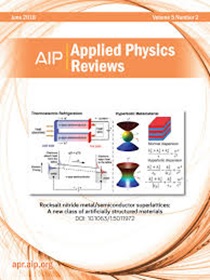One-dimensional nanotube architectures for photocatalytic hydrogen generation
IF 11.6
1区 物理与天体物理
Q1 PHYSICS, APPLIED
引用次数: 0
Abstract
One-dimensional (1D) nanotube architectures have found extensive applications in photocatalytic hydrogen generation. However, a systematic review comprehensively discussing the characteristics of these architectures and their specific applications in this field is still lacking. In this review, we first summarized the fundamentals of photocatalytic hydrogen generation and the major categories of nanotube architectures, with a particular focus on the unique features of nanotubes for photocatalytic hydrogen generation, including increased specific surface area, spatial confinement effect, cavity enhancement effect, enhanced axial and radial electron transport, reaction interface separation induced by coaxial heterostructures, improved hydrogen nucleation and diffusion, and adaptability to various photocatalytic systems. We reviewed the major categories of nanotube architectures, summarizing the overview, synthesis methods, and specific applications in wired and unwired photocatalytic hydrogen generation of the following systems: transition and metalloid oxysalts, TiO2, other metal oxides and their derivatives, transition metal pnictides and chalcogenides, carbon, carbon nitride and derivatives, other inorganic non-metallic materials, organic and organic–inorganic hybrid materials, and nickel-iron layered double hydroxides (NiFe-LDH). Finally, we explored theoretical modeling and calculations of 1D nanotube architectures for photocatalytic hydrogen generation. This review aims to systematically summarize the common and unique features of nanotubes in photocatalytic hydrogen generation, providing insights to advance research in this field.光催化制氢的一维纳米管结构
一维纳米管结构在光催化制氢中有广泛的应用。然而,系统地全面讨论这些体系结构的特点及其在该领域的具体应用仍然缺乏。本文首先综述了光催化制氢的基本原理和纳米管结构的主要分类,重点介绍了纳米管在光催化制氢中的独特特点,包括增加的比表面积、空间约束效应、空腔增强效应、增强的轴向和径向电子传递、同轴异质结构引起的反应界面分离、改善的氢成核和扩散。适应各种光催化体系。本文综述了纳米管结构的主要类别,综述了以下体系的概述、合成方法及其在有线和非有线光催化制氢中的具体应用:过渡态和类金属氧盐、TiO2、其他金属氧化物及其衍生物、过渡态金属羟基和硫族化合物、碳、氮化碳及其衍生物、其他无机非金属材料、有机和有机-无机杂化材料、镍铁层状双氢氧化物(NiFe-LDH)。最后,我们探索了光催化制氢的一维纳米管结构的理论建模和计算。本文旨在系统总结纳米管在光催化制氢中的共性和独特性,为该领域的进一步研究提供参考。
本文章由计算机程序翻译,如有差异,请以英文原文为准。
求助全文
约1分钟内获得全文
求助全文
来源期刊

Applied physics reviews
PHYSICS, APPLIED-
CiteScore
22.50
自引率
2.00%
发文量
113
审稿时长
2 months
期刊介绍:
Applied Physics Reviews (APR) is a journal featuring articles on critical topics in experimental or theoretical research in applied physics and applications of physics to other scientific and engineering branches. The publication includes two main types of articles:
Original Research: These articles report on high-quality, novel research studies that are of significant interest to the applied physics community.
Reviews: Review articles in APR can either be authoritative and comprehensive assessments of established areas of applied physics or short, timely reviews of recent advances in established fields or emerging areas of applied physics.
 求助内容:
求助内容: 应助结果提醒方式:
应助结果提醒方式:


